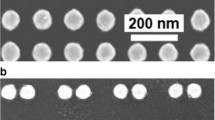Abstract:
The light scattering by three-dimensional clusters supported by a substrate is modelled by representing clusters by truncated spheroids whose polarizability is calculated via a multipolar development of the potential in the quasi-static limit. The determination of the mean island radius, density and aspect ratio from the optical response is examined. The strong influence of both the particle-substrate interaction and the particle shape on the optical behaviour is demonstrated, showing the limits of effective medium and dipolar theories. The Surface Differential Reflectance spectra of silver on MgO(100) and titanium or aluminium on α-Al2O3(0001) surfaces have then been modelled by using the above model, illustrating the capability of optical means to deal with various metals, including those belonging to transition series. In all cases, it is highlighted that the aspect ratio is central in modelling the optical response of supported particles.
Similar content being viewed by others
Author information
Authors and Affiliations
Additional information
Received 5 June 2000 and Received in final form 31 July 2001
Rights and permissions
About this article
Cite this article
Lazzari, R., Simonsen, I., Bedeaux, D. et al. Polarizability of truncated spheroidal particles supported by a substrate: model and applications. Eur. Phys. J. B 24, 267–284 (2001). https://doi.org/10.1007/s100510170014
Issue Date:
DOI: https://doi.org/10.1007/s100510170014




